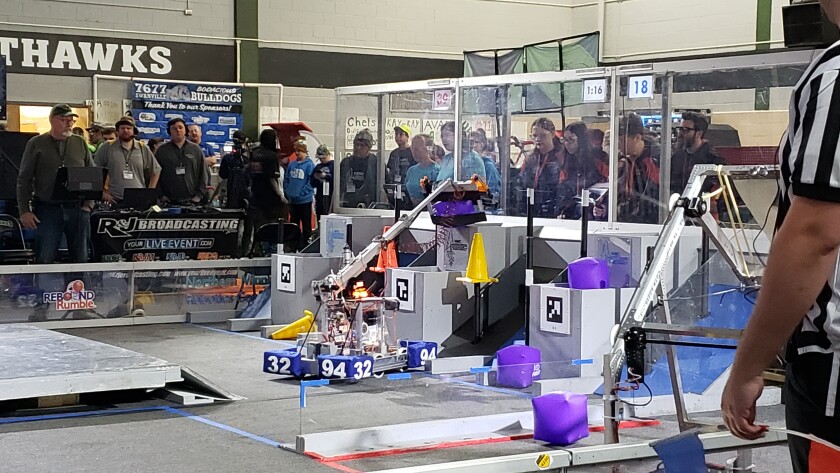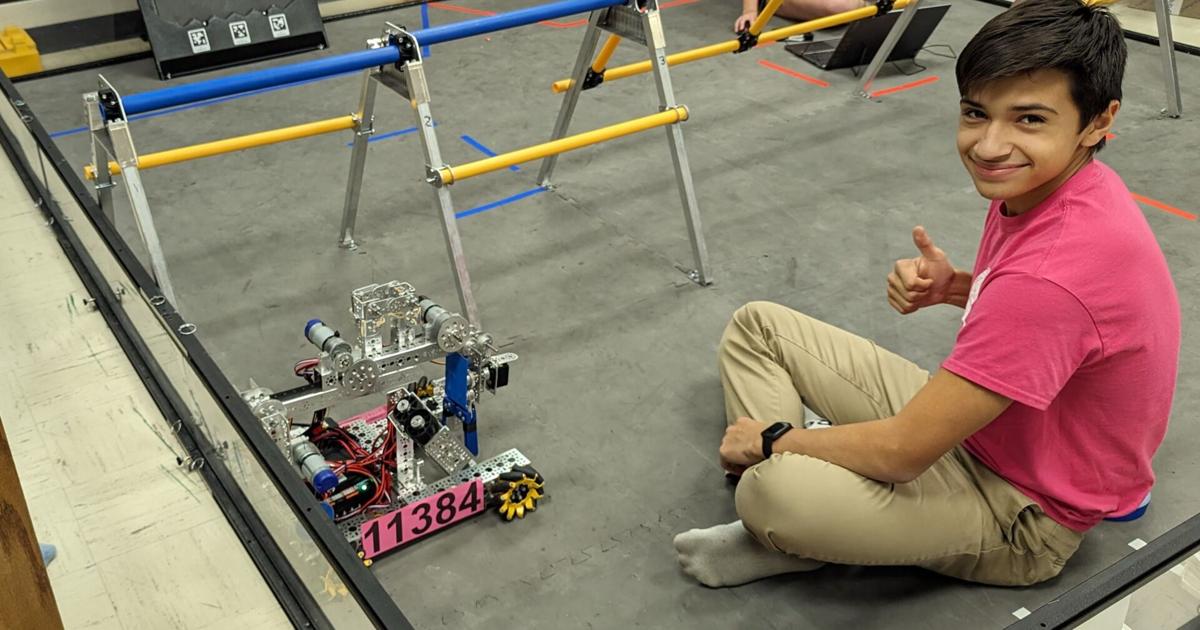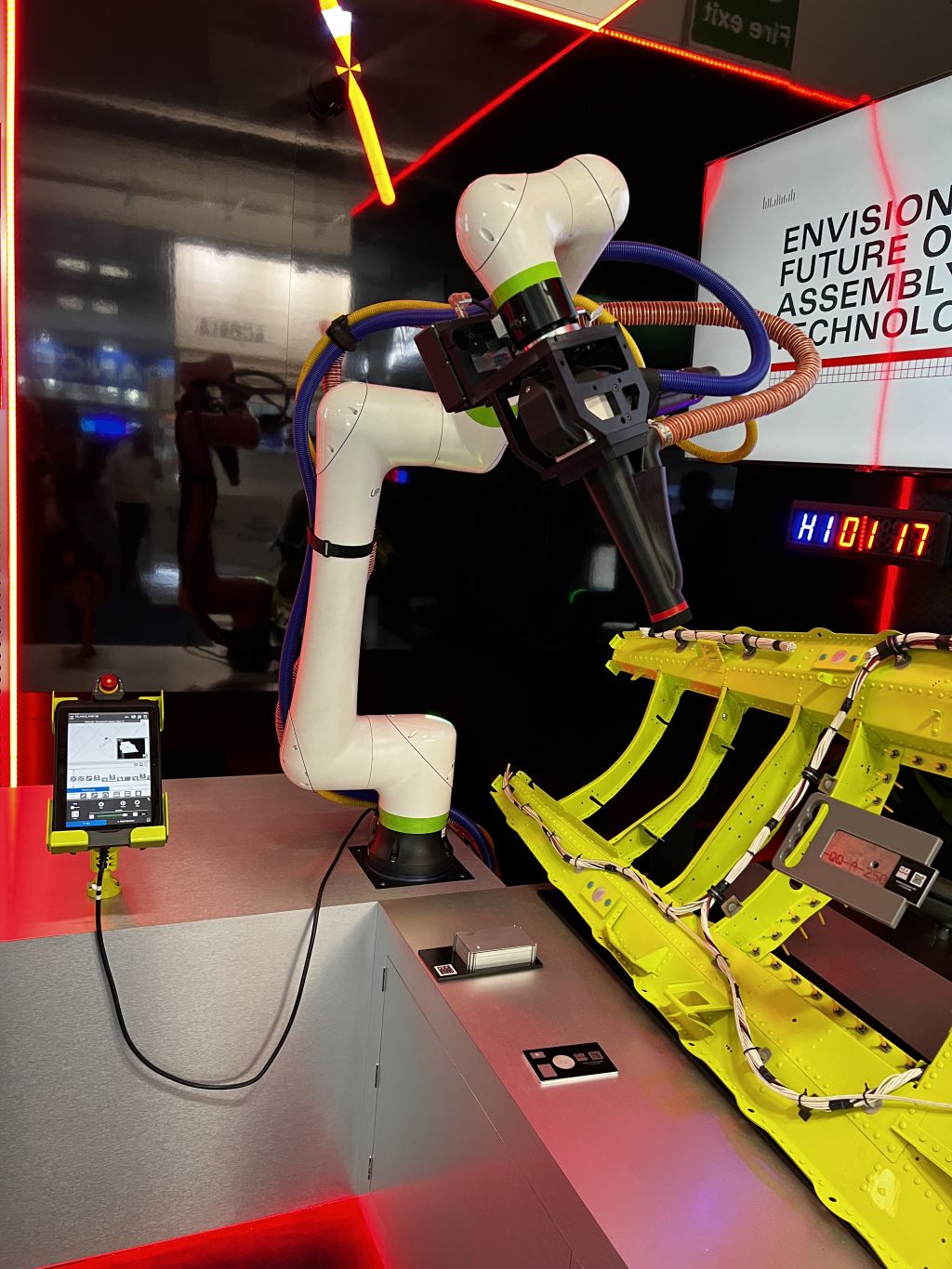BABBITT — The Pine River-Backus robotics team hauled their tools, computers, robot and hopes to Babbitt on Friday Oct. 27, for a two-day tournament organized by the Northern Minnesota Robotics Conference, and brought home a first-place trophy.
For almost half of the students on the team, this was their first in-person competition in one of Minnesota’s newest officially sanctioned high school sports.
The NMRC has been providing this event since forming in 2017 as a conference of FIRST Robotics Competition teams in greater Minnesota. The NMRC Championship has been a “traveling” event hosted generally by the schools of various member teams.
This year, the Iron Mosquitos of Babbitt took on the host duties and welcomed 16 visiting teams for two fun, but intense, days of friendly competition.
Contributed / Andrew Rudlang
The game was “Charged Up,” the same game that FRC teams competed in for the 2023 winter season. The challenges set for robots in this game included picking up two types of game pieces (plastic “cones” and inflatable “cubes”) and scoring those pieces for points in elaborate scoring “grids” on each end of the playing field.
Scored game pieces incurred different numbers of points depending on where in the grid they were scored, as well as what combinations the pieces were arranged in.
The endgame challenge involved driving the robots onto a double-hinged balance board known as the charging station, which could provide match-turning bonus points if balanced successfully but also posed significant risk of tipping over the large machines the students had built.
Robots in FRC can be as large as a dishwasher and weigh over 100 pounds each.
Matches are played with two opposing alliances of three robots each, although the Pine River-Backus team got a hard start in their first qualification match when one of their alliance robots was broken, resulting in an uphill battle of a 2-vs-3 match since there are no team substitutions in qualifications.
The PR-B team on the two-robot side of the match was outscored by the opposing full team of three robots, although the final match score of 63 to 86 was respectable considering that the losing side was missing an entire robot.

Contributed / Andrew Rudlang
The PR-B team persevered and ended qualification matches with an overall ranking of sixth.
In the semifinals and finals, alliances are no longer randomized and ranking points from obtaining game objectives no longer apply. The top four ranked teams each build a static alliance of three robots by choosing two teams each to play with them from the remaining participants, and then those top four alliances (12 robots total) play out a bracket of matches to ultimately determine the first-, second- and third-place alliances for the event.
The Frazee team had finished qualifying with a No. 3 ranking, so they were one of the teams choosing other teams to play with them in the semifinals and finals. Frazee picked the Babbitt and Pine River-Backus teams to be on their alliance, and together they came up with a match strategy to build on each other’s strengths.
The Frazee team’s robot was designed around the “cone” game pieces and was able to quickly pick and place the cones onto the scoring grid. Babbitt’s specialty was speed and agility; they could collect the cube game pieces rapidly from across the 50-foot field and pile them up within the alliance’s safe zone.
Pine River-Backus was able to accurately pick and place the cubes delivered by the Babbitt team with their extendable arm onto the scoring grid, and the narrow profile of the PR-B robot made it easier for all three robots to climb together onto the tipping charging station at the end of the match for the endgame bonus points.
Together, the trio entered the single-elimination semifinals. They finalized their strategy and set it to work. They won both semifinal matches with scores of 102 to 91, and 102 to 83.
Finals were a “best two out of three” to decide whether the alliance would capture first or second place. The Frazee/Babbitt/PR-B trio took the first match 98 to 96, and the crowd let out an audible gasp as the round ended with a tie score of 105 to 105. The match had to be replayed, since there can be no ties in finals.
All six robots were reset for another round in their maintenance pits, with some needing emergency repairs as the cumulative wear and tear of the event had become more apparent with each passing round.

Contributed / Andrew Rudlang
The three teams leaned full force into their chosen strategy. Frazee zipped along the field scoring cones while dodging opposing robots. Babbitt ferried cubes across the field at top speed, deftly delivering some to the PR-B robot and scoring several directly into the grid themselves.
Pine River-Backus grabbed and placed the delivered cubes, trying to find the best combinations of game pieces in the grid to press the score higher and higher. As the last seconds of the match ticked down, Frazee and PR-B lined up on the balance board while Babbitt placed a final cube into the scoring grid before joining them, and the group rolled up the tipping ramp in unison and placed the charging station into a balanced state.
The score as the buzzer rang was seven points in favor of the Frazee/Babbitt/PR-B alliance, but nobody knew for sure if latent foul points or other factors would tilt the final score.
All six robots had managed to balance on their respective charge stations, so an additional 30 points were added to each alliance’s final score. No additional fouls or factors came out as the officials finalized the scores, so the final match of the event ended 117 to 110 in favor of the Frazee/Babbitt/PR-B alliance.
The winners received trophy plaques in the awards ceremony. For the Pine River-Backus team, the first-place award joins their second-place award from the NMRC’s tournament in 2021, and their third-place award from the same event in 2017.
The championship banner that accompanies the first-place plaque will join the other sports banners in the gym at PR-B School after the team takes the banner on tour for the rest of their events this school year.
Andrew Rudlang is a Pine River-Backus robotics team coach.











